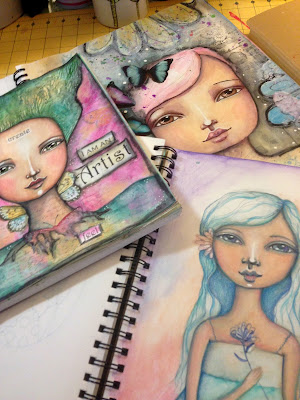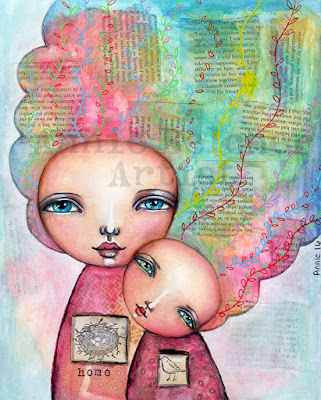Welcome to the 3rd installment of Art Journal 101!
This section is all about mark making
As a starting off point i thought i would discuss the materials i use most often and we will just go from there.
Pencil
I do use graphite a lot to draw with, especially if i am creating my whimsy girls. I rarely get my proportions right the first time so I do a lot of erasing.
My favorite pencil is a mechanical one made by Pentel. I bought mine at Blick, but I have seen them other places as well. The one I use is called Graphgear 500 and the lead I use is size 0.9 I find this one soft enough to make bold lines but still easy to erase.
Erasers
As I said, I do tend to erase a lot and my preferred eraser is a kneaded eraser. I love these erasers because you can make them any shape, to get into tight areas, etc. They are great for getting rid of smudges, and you can use them to make a pencil line lighter too! I use any brand that is cheap and I always find them at the art supply store in the drawing section.
Markers
I use lots of different markers in my journals for lots of different things. Sometimes i write my thoughts with a bold black marker across the page and then create art over it, so that it becomes the first layer and ends up acting as texture for the page. This is great when you want to get your thoughts out but don't necessarily want anyone to read it.
Some of the markers I use for this are Sharpies and Pigma Microns, both of which are permanent.
My absolute favorite type of marker is the Uni Posca pens from Japan. These are paint pens and they generally write over anything. They last a long time and come in a great variety of colors. They come in a variety of true pastel colors which you just don't see anywhere. I find it amusing that the pastel set is referred to as "natural colors". I get them either on Amazon or from Jetpens.com.
My absolute favorite type of marker is the Uni Posca pens from Japan. These are paint pens and they generally write over anything. They last a long time and come in a great variety of colors. They come in a variety of true pastel colors which you just don't see anywhere. I find it amusing that the pastel set is referred to as "natural colors". I get them either on Amazon or from Jetpens.com.
Another type of marker I use a lot are the Tombow Brush pens. These are really fun because they are highly pigmented so they are nice and bright and they are water soluable, so you can use them like watercolors. They are wonderful for journaling! I get them at Blick but I have also bought sets on Amazon.
Colored Pencils
I use colored pencils a lot for shading faces and my favorites for years has been Prismacolor. I have been using them for so long I can recall the times they were called Sanford, and Berol! I have quite a few, though not the whole set.
I also have a set of verithins-which are made by the same company. They are harder and great for sharp edges.
Another brand of colored pencils that I enjoy are called Irojiten. They are from Japan and come in lots of pastel colors. They come packaged in little books so you can collect the whole library of them. They are smooth and blend very nicely. I bought these from Amazon.
And lastly I use watercolor pencils. My preferred brand is Inktense by Derwent. These are fantastic because they are so vibrant. They activate with water and then dry permanent which is great when you are adding wet layers on top. I have purchesed these at Blick.
Ink
I use a variety of ink mostly for creating drips and spatters.Sometimes I write with them in my journal using a dip pen. Any ink will do for this, there is no need to spend a fortune. The brands I have collected are Daler Rowneys FW, and Bombay. I also splurged on a set of Dr. P. H. Martin's Hydrus Liquid Watercolors which I use sparingly for this purpose. All of these I have purchased at art supply stores.
So those are my basic supplies for writing. Next week I will talk about paint!
~Annie















































